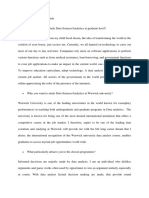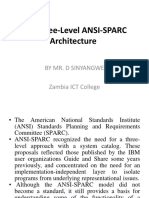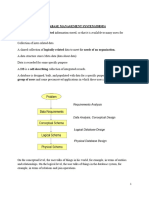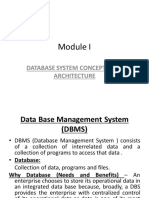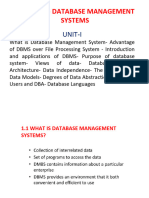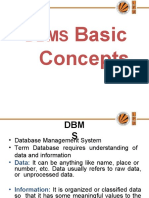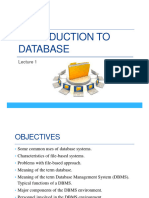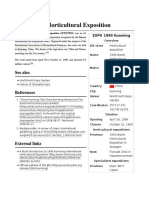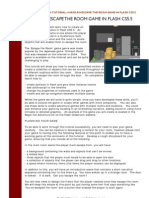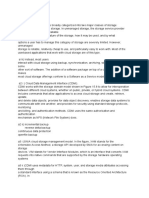Deck 01 Database Technology
Deck 01 Database Technology
Uploaded by
Eida IzanamiCopyright:
Available Formats
Deck 01 Database Technology
Deck 01 Database Technology
Uploaded by
Eida IzanamiOriginal Description:
Original Title
Copyright
Available Formats
Share this document
Did you find this document useful?
Is this content inappropriate?
Copyright:
Available Formats
Deck 01 Database Technology
Deck 01 Database Technology
Uploaded by
Eida IzanamiCopyright:
Available Formats
Database
Systems
DECK 01
Low Yin Jye
Database
Technology
45 Minutes
Learning Outcomes
• Introduction to Database
• File-Based Systems
• File-Based Processing
• Limitation of File-Based Approach
• The Database Approach
• What is a Database?
• Database Management System (DBMS)
• Generations of Database
• Advantages of DBMS
• Disadvantages of DBMS
• ANSI-SPARC Three-Level Architecture
• Database Application Life Cycle
Introduction to Database
What are some database examples?
File-Based Systems
• Collection of application programs that perform
services for the end users (e.g. reports).
• Each program defines and manages its own data.
File-Based Processing
Limitations of File-Based Approach
• Separation and isolation of data
• Duplication of data
• Data dependence
• Incompatible file formats
• Fixed Queries/Proliferation of application
programs
The Database Approach
• Arose because:
Definition of data was embedded in application
programs, rather than being stored separately and
independently.
No control over access and manipulation of data
beyond that imposed by application programs.
• Result:
The database and Database Management System
(DBMS).
What is a Database?
• Shared collection of logically related data (and a
description of this data), designed to meet the
information needs of an organization.
• System catalog (metadata) provides description
of data to enable program–data independence.
• Logically related data comprises entities,
attributes, and relationships of an organization’s
information.
Database Management System (DBMS)
• A software system that enables users to define,
create, and maintain the database and that
provides controlled access to this database.
Database Management System (DBMS)
Generations of Database
• First generation • Third generation
Hierarchical Object Relational
Network Object-Oriented
• Second generation • Fourth generation
Relational Graph
NOSQL
Advantages of DBMS
• Control of data redundancy
• Data consistency
• More information from the same amount of data
• Sharing of data
• Improved data integrity
• Improved security
• Enforcement of standards
• Economy of scale
Advantages of DBMS
• Balanced conflicting requirements
• Improved data accessibility and responsiveness
• Increased productivity
• Improved maintenance through data
independence
• Increased concurrency
• Improved backup and recovery services
Disadvantages of DBMS
• Complexity
• Size
• Cost of DBMS
• Additional hardware costs
• Cost of conversion
• Performance
• Higher impact of a failure
ANSI-SPARC Three-Level Architecture
• The ANSI-SPARC Architecture (American National
Standards Institute, Standards Planning And
Requirements Committee), is an abstract design
standard for a database management system (DBMS),
first proposed in 1975.
• The ANSI-SPARC model however never became a
formal standard. No mainstream DBMS systems are
fully based on it (they tend not to exhibit full physical
independence or to prevent direct user access to the
conceptual level), but the idea of logical data
independence is widely adopted. https://en.wikipedia.org/wiki/ANSI-SPARC_Architecture
ANSI-SPARC Three-Level Architecture
User Objectives of Three-Level Architecture
• All users should be able to access same data.
• A user’s view is immune to changes made in
other views.
• Users should not need to know physical
database storage details.
DBA Objectives of Three-Level Architecture
• Database Administrator (DBA) should be able to
change database storage structures without
affecting the users’ views.
• Internal structure of database should be
unaffected by changes to physical aspects of
storage.
• DBA should be able to change conceptual
structure of database without affecting all users.
Three-Level Architecture in Details
• External Level
Users’ view of the database.
Describes that part of database that is relevant to a
particular user.
• Conceptual Level
Community view of the database.
Describes what data is stored in database and
relationships among the data.
• Internal Level
Physical representation of the database on the
computer.
Describes how the data is stored in the database.
Three-Level Architecture in Details (Table)
INTERNAL LEVEL CONCEPTUAL LEVEL EXTERNAL LEVEL
Physical Storage in It describes the This level is the closest to
database structure of whole the users
database for users
This level is close with It represent all entities, It is the way how the data is
physical storage of attributes and their view by individual users
data relationship
It can view in the form It contain all the Describes the segment of
of files information to build the database that is required
the relevant external for a particular user group
records and hides the rest of the
database from that users
Data compression and It hides the internal Describe part of database,
encryption techniques details of physical that is relevant to each
are applied at this level storage users.
Data Independence
Logical Data Independence
• Logical Data Independence
Refers to immunity of external schemas to changes in
conceptual schema.
Conceptual schema changes (e.g. addition/removal of
entities).
Should not require changes to external schema or
rewrites of application programs.
Physical Data Independence
• Physical Data Independence
Refers to immunity of conceptual schema to changes
in the internal schema.
Internal schema changes (e.g. using different file
organizations, storage structures/devices).
Should not require change to conceptual or external
schemas.
Database Application Life Cycle
Database Application Life Cycle
Database Application Life Cycle (List)
1. Database Planning Developers verify the needs for database, goals and
the tools to accomplish its goals.
2. Requirement Analysis Determine all objectives of the database and how
does it support the application?
3. Database Design Organising all the pieces of data in tables and deciding
how best to link its data to each other.
4. Prototype Example of database system but lack features for final system.
It is to allow users identify features that work well or not
5. Implementation Apply the solution to the existing problem
6. Data Conversion & Loading Migrate existing data to the new database
and convert any existing application to connect to the new database
7. Testing Before it is release, we have to test its features and eliminate
errors & bugs.
8. Operation Maintenance After testing, continue to monitor the
performance of the system and to make changes if required
Stages in Database Design
END
You might also like
- Ch2 Ch3 MinaDocument10 pagesCh2 Ch3 MinaMena EssamNo ratings yet
- 2 Day Boot Camp On Internet of Things - Pune PDFDocument3 pages2 Day Boot Camp On Internet of Things - Pune PDFRavin KancharlaNo ratings yet
- Personal StatementDocument3 pagesPersonal Statementedith kuruiNo ratings yet
- 1.1. Introduction To DBMSDocument19 pages1.1. Introduction To DBMSVarshini SenthilNo ratings yet
- DBMSDocument61 pagesDBMSsangiwenmoyoNo ratings yet
- ISYS6028 Session 2 - Database EnvironmentDocument30 pagesISYS6028 Session 2 - Database EnvironmentJauharAzkaNo ratings yet
- Dbms Basics Unit 1Document49 pagesDbms Basics Unit 1Shivaay sharmaNo ratings yet
- 4 The Three-Level ANSI-SPARC ArchitectureDocument25 pages4 The Three-Level ANSI-SPARC Architecturejonnathan mandelaNo ratings yet
- Review Question CHDocument6 pagesReview Question CHnour ghanaymNo ratings yet
- DBMSDocument139 pagesDBMSkushagraNo ratings yet
- Dbms QB Solution Tt-1Document15 pagesDbms QB Solution Tt-1Ojas PatilNo ratings yet
- W2. Database EnvironmentDocument40 pagesW2. Database EnvironmentSABOOR UR RAHMANNo ratings yet
- DBMS LectureDocument24 pagesDBMS Lectureartrebel189No ratings yet
- Database System Concepts and ArchitectureDocument30 pagesDatabase System Concepts and ArchitectureAyush RathoreNo ratings yet
- Unit 1Document35 pagesUnit 1ssNo ratings yet
- 1.architecture of DBMSDocument27 pages1.architecture of DBMSanishaNo ratings yet
- CS3492 DBMS (Unit 1)Document75 pagesCS3492 DBMS (Unit 1)Muppudathi RNo ratings yet
- Mid ExamDocument5 pagesMid ExamFahad RazzaqNo ratings yet
- Database Systems Concepts: Introduction To DatabasesDocument30 pagesDatabase Systems Concepts: Introduction To Databasesarch077No ratings yet
- L1-5 mergedDocument114 pagesL1-5 mergedblackman250aNo ratings yet
- Unit 1 - Part 1Document44 pagesUnit 1 - Part 1Harsh BhardwajNo ratings yet
- Introduction To Databases: By: Aisha BatoolDocument30 pagesIntroduction To Databases: By: Aisha BatoolUmar KhanNo ratings yet
- Unit 1 - Part 1Document66 pagesUnit 1 - Part 1Pawan KumarNo ratings yet
- Chapter 1Document50 pagesChapter 1yishaktumoregideNo ratings yet
- DBMS Unit 1Document47 pagesDBMS Unit 1Faisal Nazir (ANDY)No ratings yet
- Dbms Chap 01Document52 pagesDbms Chap 01Krishaan SoniNo ratings yet
- DBMS SlidesDocument127 pagesDBMS SlidesAmit KushwahaNo ratings yet
- Database Systems: by Neil A. BasabeDocument33 pagesDatabase Systems: by Neil A. BasabeNeil Basabe100% (1)
- IE - DBMS - Module 1Document38 pagesIE - DBMS - Module 11DS19AU006 AJITH KUMAR S NNo ratings yet
- Dbms Unit1Document57 pagesDbms Unit1anshdarock222No ratings yet
- Module 1Document134 pagesModule 1sneha04.rajuNo ratings yet
- Database and Data ModelingDocument31 pagesDatabase and Data ModelingKudakwashe MotsiNo ratings yet
- DBMS MergedDocument566 pagesDBMS MergedFIZA SAIFNo ratings yet
- DBMS Unit 1 NotesDocument41 pagesDBMS Unit 1 NotesSaisubramanian VNo ratings yet
- Chapter 2 - Database EnvironmentDocument25 pagesChapter 2 - Database EnvironmentLoveHillary'sNo ratings yet
- Presentation2 Three Level ArchDocument19 pagesPresentation2 Three Level Archanasriaz2586No ratings yet
- dbms-unit-1_aktuDocument20 pagesdbms-unit-1_aktupaswanraja802No ratings yet
- Introduction Basis DataDocument59 pagesIntroduction Basis DatamamluatulNo ratings yet
- RDBMS - M01 - C01 - PPT - Overview of Database Management SystemDocument47 pagesRDBMS - M01 - C01 - PPT - Overview of Database Management SystemAman SharmaNo ratings yet
- Unit 1 DBMSDocument116 pagesUnit 1 DBMSjgjeslinNo ratings yet
- Database Environment: File Processing and Database Management SystemDocument13 pagesDatabase Environment: File Processing and Database Management SystemKing JazzNo ratings yet
- DBMS - CH1Document39 pagesDBMS - CH1Divit wadhwaniNo ratings yet
- The Database Management System DBMSDocument15 pagesThe Database Management System DBMSRichard LumawagNo ratings yet
- DBMS ArchitectureDocument35 pagesDBMS ArchitectureNaman BajajNo ratings yet
- Database EnvironmentDocument20 pagesDatabase EnvironmentAnonymous 6jZZaDOLkNo ratings yet
- DBMS First ChapterDocument24 pagesDBMS First ChapterRebel Sangamesh HNo ratings yet
- Lecture03 - IDB - Fall 24-25Document21 pagesLecture03 - IDB - Fall 24-25mishalhosnNo ratings yet
- Dbms Unit 1 Acoording To AKTU SyllabusDocument22 pagesDbms Unit 1 Acoording To AKTU Syllabusmukesh.iilm144100% (1)
- ME DBMS Unit1 FinalDocument139 pagesME DBMS Unit1 FinalSendurusrinivas NadarNo ratings yet
- Module 01Document14 pagesModule 01Shreyas B RNo ratings yet
- Lecture03 IDBDocument21 pagesLecture03 IDBmahfuzarnab21No ratings yet
- 1_1.Introduction databaseDocument29 pages1_1.Introduction databaseSumit DebnathNo ratings yet
- Guide To DatabasesDocument47 pagesGuide To DatabasesAnne RosalesNo ratings yet
- SWE DataBaseDocument56 pagesSWE DataBasenkoloamandineNo ratings yet
- Lec 2Document23 pagesLec 2hghauri30No ratings yet
- Unit 1 DBMSDocument116 pagesUnit 1 DBMSjgjeslinNo ratings yet
- Basic ConceptsDocument33 pagesBasic Conceptskiller GamingNo ratings yet
- Unit1 - FinalDocument71 pagesUnit1 - FinalRoshan ChoudharyNo ratings yet
- Unit 1 Part 2Document31 pagesUnit 1 Part 2Shreyansh 1485No ratings yet
- Introduction of DB: Database System Concepts and ArchitectureDocument23 pagesIntroduction of DB: Database System Concepts and ArchitectureZahid AhmadNo ratings yet
- DBMS_1Document85 pagesDBMS_1maheshgiri9988No ratings yet
- Lecture 1 - Introduction To DatabaseDocument22 pagesLecture 1 - Introduction To DatabasekriteshpokhrelNo ratings yet
- Cisco Webex Event Center User GuideDocument476 pagesCisco Webex Event Center User GuideNATALIJA DIMOVSKANo ratings yet
- Caesar Cipher (Shift) - Online Decoder, Encoder, Solver, TranslatorDocument1 pageCaesar Cipher (Shift) - Online Decoder, Encoder, Solver, TranslatorCarter SneedNo ratings yet
- HackerRank 2019 2018 Developer Skills ReportDocument28 pagesHackerRank 2019 2018 Developer Skills ReportAlbus SeverusNo ratings yet
- Information Security Management and MetricsDocument30 pagesInformation Security Management and MetricsAdityaNo ratings yet
- Prepaid Voice Services Based On Openbts PlatformDocument12 pagesPrepaid Voice Services Based On Openbts PlatformMahmood AdelNo ratings yet
- Bhavesh Jain Salesforce Functional ConsultantDocument4 pagesBhavesh Jain Salesforce Functional ConsultantBhaveshNo ratings yet
- Performance Management PlanDocument14 pagesPerformance Management Planmkpasha55mpNo ratings yet
- Internet TermsDocument344 pagesInternet Termskyashwanth100% (34)
- CST 370 Assignment 6Document10 pagesCST 370 Assignment 6api-596655668No ratings yet
- 1999 World Horticultural ExpositionDocument2 pages1999 World Horticultural Expositionineed2downloadfromscribdNo ratings yet
- LES - V2 - 20200807 SCADA Specification Rev02Document21 pagesLES - V2 - 20200807 SCADA Specification Rev02Samson ObinnaNo ratings yet
- Eye Tracking VR ImotionsDocument3 pagesEye Tracking VR ImotionsÁngrlNo ratings yet
- U14EC509: SEMINAR: (An Autonomous Institute Under Kakatiya University, Warangal)Document16 pagesU14EC509: SEMINAR: (An Autonomous Institute Under Kakatiya University, Warangal)Dadi VinayNo ratings yet
- CH 2Document62 pagesCH 2genetNo ratings yet
- Tecccie 8002Document294 pagesTecccie 8002Yordan PetkovNo ratings yet
- Configuration For Project 64: Nintendo 64 EmulatorDocument17 pagesConfiguration For Project 64: Nintendo 64 Emulatorc23lueyNo ratings yet
- Network Monitoring and Analysis by Packet Sniffing MethodDocument3 pagesNetwork Monitoring and Analysis by Packet Sniffing MethodseventhsensegroupNo ratings yet
- TBC 501 Android Programming (1)Document3 pagesTBC 501 Android Programming (1)koshikjoshikjNo ratings yet
- Z4H98PA HP Spectre x360 - 13-W007tu: Product Model: Product Name: Product Serial NumberDocument3 pagesZ4H98PA HP Spectre x360 - 13-W007tu: Product Model: Product Name: Product Serial NumberAndrian4979No ratings yet
- SQLXDocument79 pagesSQLXpramod_rp2007No ratings yet
- OCB SSP ProblemsDocument2 pagesOCB SSP ProblemsJayakrishna ReddyNo ratings yet
- Unit 4 Spatial AnalysisDocument21 pagesUnit 4 Spatial AnalysisNurwatik GeomaticsNo ratings yet
- PDMS Pipe Support DesignDocument25 pagesPDMS Pipe Support DesignFWICIPNo ratings yet
- Escape The RoomDocument12 pagesEscape The RoomAkiko HiuraNo ratings yet
- New Smart Meter Thesis Report PDFDocument80 pagesNew Smart Meter Thesis Report PDFRoland100% (1)
- Module 1 - Attacks On Computer SecurityDocument28 pagesModule 1 - Attacks On Computer Securityidris ahmed khanNo ratings yet
- PT 2 Answer Key - EditedDocument6 pagesPT 2 Answer Key - EditedJdking MonsterNo ratings yet


